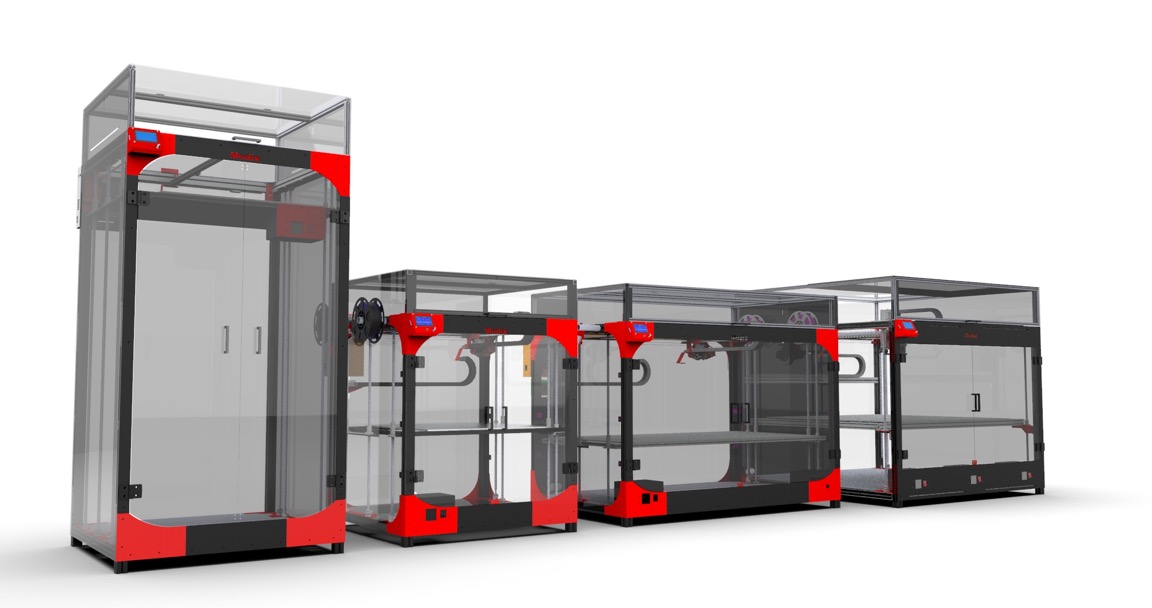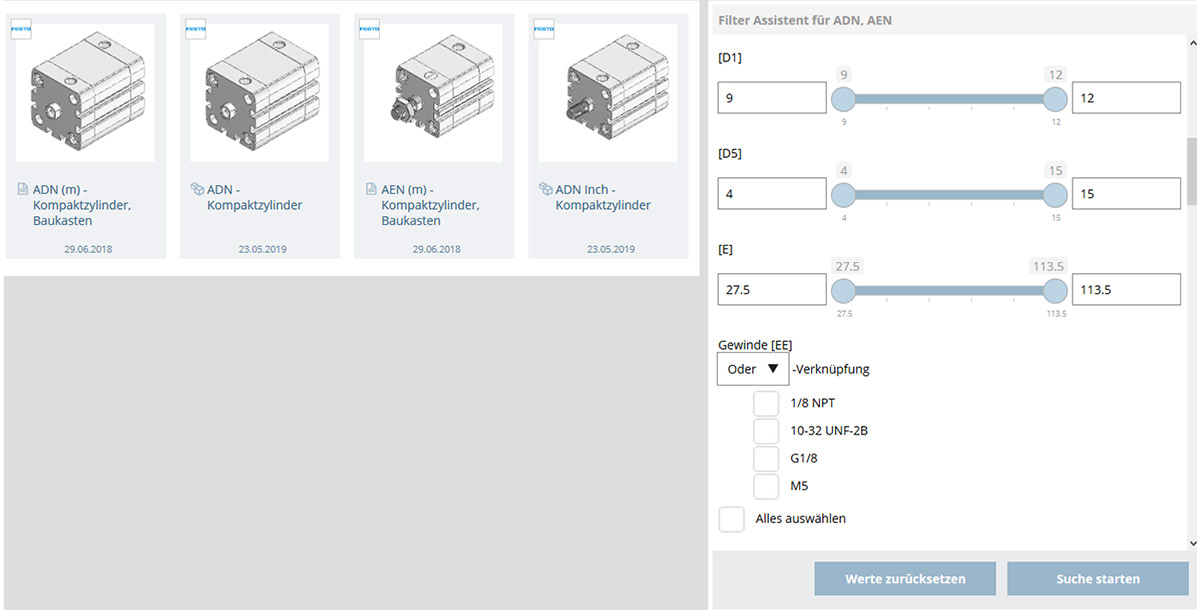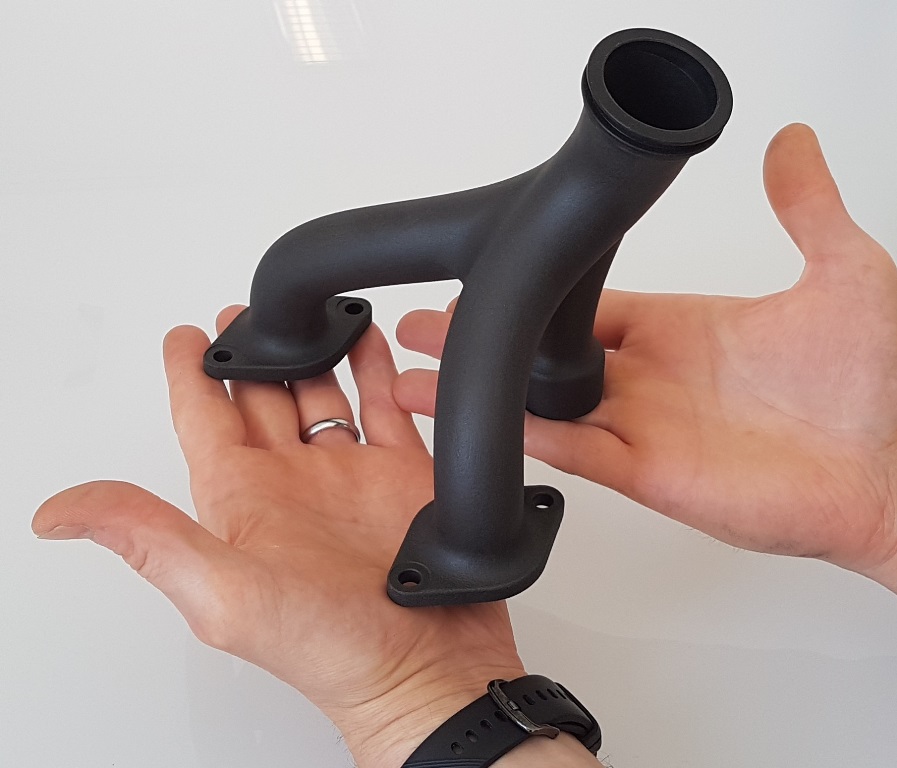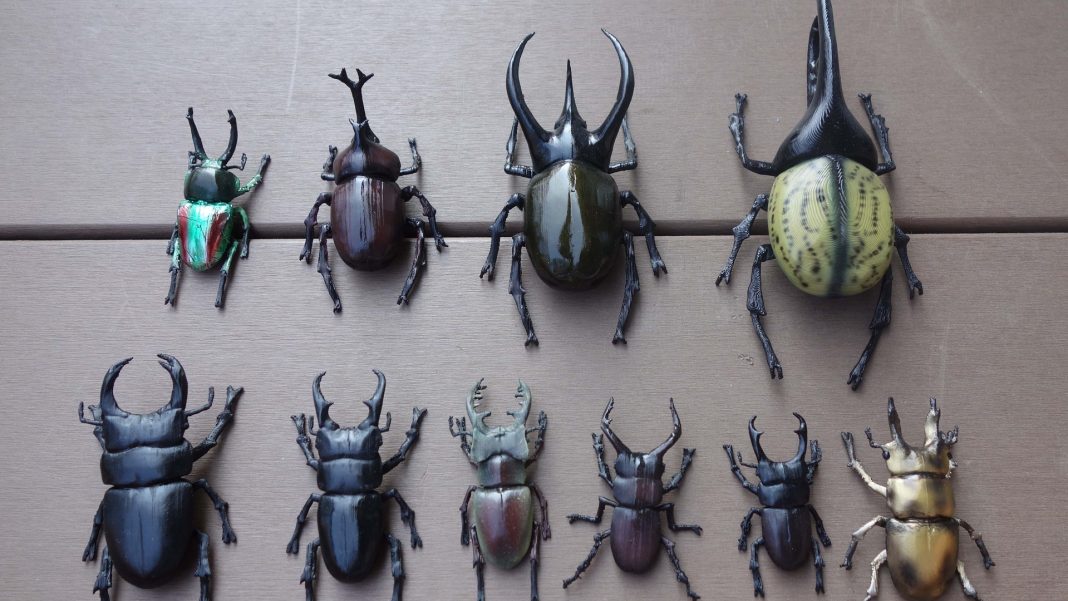This week’s edition of Sliced, the 3D Printing Industry news digest features, the latest large scale 3D Printers from Modix, a new Windform FR1 Flame Retardant composite from CRP Technology, and new 3D printing facilities at the University of Salford.
We also cover Alfa Romeo F1 Racing, Xometry, Roboze, OpenAdditive, Florida Makes, Rosswag Engineering, SLD Laser, Sintavia, Polymaker, ExOne and more.
Beginners guide to different 3D printing processes
Xometry, Maryland-based on-demand manufacturing service, and 3D printing service has launched a series of educational videos on 3D Printing. In a new YouTube series of videos called The X Tiles, Greg Paulsen, Xometry’s Director of Applications Engineering, walks viewers through the strengths and tradeoffs of different processes and materials used for 3D Printing. The videos uploaded so far have tackled SLS vs HP MJF / Polyjet vs SLA / DMLS: Stainless Steel vs Aluminum and SLS vs FDM.
Tel Aviv-based 3D printer self-assembly kit maker Modix has announced four New large scale 3D Printers. The new models are based on Modix’s own modular design and will expand the existing product line which already includes the Big-60 and Big-120X. The new models are:
- Big-1000 – a shorter version than Big-120X, yet wider base.
- Big-120Z – A 1.2 Meter tall printer, for sculptors, fashion & advertising industries.
- Big-180X – A relatively long 3D printer, mainly for the automotive industry.
- Big-40 – A Smaller foot print for tall and narrow models.
The company says the new printers will be available as soon as 2019/Q3.

OEM OpenAdditive has released the specifications for its PANDA laser powder bed fusion system. The printer has a build volume of 152 mm x 152 mm x 178 mm and a 500W IPG air-cooled Yb-fiber laser. The system has no restrictions on materials and allows easy access for powder fills/swaps, room to mount sensors and custom mechanisms, and large windows for visual observation.
Growing demand for 3D printers
In other hardware news, Italian 3D printing company Roboze has announced plans to quintuple production of its Argo 500 3D printers by 2020 in response to growing demand. The company states that over the next six months it has a number of shipments planned for customers in the aerospace, motorsport, oil and gas and automotive industries. The Argo 500 has attracted the attention of companies across these industries for its ability to produce one-off custom parts and small batch runs.
“The great demand we are receiving for Argo 500 demonstrates the growing interest of the market toward this kind of production solution,” said, Alessio Lorusso, CEO and Founder of Roboze. “This year, we’re almost sold-out with Argo 500, purchased by some of the biggest global industry leaders in the aerospace, defense and oil and gas sectors.”
Rotterdam based Verstegen Spices & Sauces, a producer and supplier of herbs, spices, sauces, marinades have announced that It will be the first company to use byFlow’s Focus 3D Food Printer with ready-to-use fillings. The companies have also collaborated in scaling up production capacity with 3D Food Printing farm, which simultaneously prints different parts of dishes.
Alfa Romeo F1 Racing, part of the Sauber Group, has ordered a 4th MetalFAB1 system from Additive Industries. With this latest acquisition, Sauber Engineering becomes the largest global customer of Additive Industries.
“Only two years ago we announced the technology partnership at Rapid.Tech and bought two MetalFAB1 systems that would be extended to two 6 module systems in three years,” said, Christoph Hansen, Head of Technical Development at Sauber Engineering AG. “In the meantime, we have accelerated the upgrade, installed a third system and now ordered a fourth one, all in two years’ time. In parallel, we are expanding our in-house capabilities with post-process machining and HIPing.”

Rosswag Engineering, a division of die-forged product provider Rosswag GmbH, has announced the acquisition of its third selective laser melting (SLM) 3D printer from SLM Solutions. The machine, an SLM 280, was recently delivered and installed at Rosswag Engineering’s facility in Pfinztal, Germany and will enable the company to expand its production and development capabilities and support the advancement of the SLM by qualifying new alloy powders and parameters.
SLD Laser, a leading producer of laser-based light sources and blue laser products, has exhibited its elite blue laser module for industrial materials processing at Laser World of Photonics 2019.
James Raring, President of SLD Laser said, “SLD’s blue laser light modules feature up to 12 times the absorption, processing quality and speed compared to infrared laser technology. This technology produces superior results in copper, aluminum, stainless steel, as well as other metals such as nickel, gold, titanium, and silver that are commonly used for plating, other thin metal processes, and 3D printing.”
In software news, the German software manufacturer CADENAS has presented the latest version of its 3D CAD download portal PARTcommunity. Referred to as Version 9, it simplifies the locating of desired components as well as the download of CAD engineering data for engineers and purchasers. In addition, over 500 component manufacturers, who provide the CAD models of their products on the download portal, will be able to benefit from the advanced statistics tool for market analysis.

Wisconsin-based additive manufacturing service bureau, Midwest Prototyping, has announced its AS9100 Rev. D certification, the standard of operational excellence required for aviation and aerospace suppliers. The certificate means the company is now able to manufacture flight-ready components with all its 3D printing technologies, at each of its production facilities This also covers the company’s finishing services, including AMT’s PostPro3D system.
Investing in high tech 3D printing facilities
The University of Salford and Morson Group have launched two new facilities featuring the latest additive manufacturing technologies. The hubs will enable students to learn real-world engineering skills in relation to 3D printing design, manufacture, assembly, and inspection.
The two hubs include the Morson Engine Room, which features a waterjet cutter, metal additive manufacturing, large format 3D printing, state of the art electron and optical microscopes, and reverse engineering metrology instrumentation. The other hub, called the Maker Space, features a ‘Print Hive’, which is kitted out with dedicated 3D printing machines, comprising a range of Ultimate S5, 3 and 2+ machines, a Markforged composite printer, and a high-resolution SLA resin Formlabs printer.
Prof Sheila Pankhurst, Dean of the School of Science, Engineering, and Environment, said: “The University is building a long-term approach and commitment to Industry 4.0 skills across campus and actively addressing STEM skill shortages. By launching these new labs, we are launching the very best of skilled graduates to ‘Make in Salford’, and to impact the future economy.”
Metal 3D printing company Sintavia has announced that it has entered into a joint venture with Howco Group, and has opened a new 55,000 square foot facility in Florida. The facility reportedly houses more than $25 million worth of equipment, including medium and large-scale metal 3D printers, postprocessing machinery, EDMs, and wet booths. Sintavia’s founder, chairman, and CEO, Brian Neff has claimed that over the next three to five years the facility will employ 130 people and produce over $100 million in revenue annually. He also aims to open more facilities in other locations, including Houston, Phoenix, Seattle, Indianapolis, Japan, and Europe.
In Aerospace news, the testing firing of aerospace company Rocket Crafters’ rocket engine, which uses 3D printed solid fuel, has ended in a misfire. During the testing of the company’s STAR-3D Hybrid Rocket Engines, there was a hang fire as the fuel in the engine failed to ignite.
“Our igniter components absorbed too much humidity over the past month of testing. There was so much water it only smoldered,” according to an email from Mirskey. “Made with fresh materials it burned easily.”
The company said the low-cost materials, which consist of nitrous oxide and ABS plastic, eliminate the risk of an explosion and are easy to replicate. “It shows that in the case of an emergency, it still would not detonate or cause any issues on the launch pad,” propulsion engineer Kineo Wallace said.

Increasing the array of additive materials
Polymaker has launched two new industrial materials to the 3D printing market. The two materials – PolyMide PA6-CF and PA6- GF – are both fiber-reinforced Nylon polymers that display good strength and high heat deflection temperatures. Both of these materials feature Polymaker’s latest Fiber Adhesion technology, which the company claims can boost the layer adhesion of printed parts not only on the x-y axis but also on the z-axis.
CRP Technology has also released a new material – the Windform FR1 (Flame Retardant) material from the Windform TOP-LINE family of composite materials for Additive Manufacturing. It is the first Flame Retardant (UL 94 V-0 rated) material for Additive Manufacturing which is carbon fiber reinforced. It has passed the FAR 25.853 12-second vertical and 15-second horizontal flammability tests as well as the 45° Bunsen burner test.
Owing to its flame-retardant quality, the polyamide-based composite material is suitable for aircraft and aerospace applications, automotive and transportation, consumer goods, Electronics and for any parts requiring a flame retardant rating.

Elsewhere, Fishy Filaments has announced that it is now a member of the Ultimaker Material Alliance and has launched its new Porthcurno filament in 2.85mm variant. This makes Fishy Filaments the first and only supplier of “engineering-grade” recycled nylon filament in Ultimaker’s ecosystem.
Industrial 3D printer manufacturer miniFactory has announced that material-technical datasheets are now available. The datasheets consist of information about the characteristics of 3D printed parts made with the miniFactory Ultra 3D printer. The first batch of technical datasheets describes the mechanical characteristics of ULTEM AM1010F and ULTEM AM9085F by SABIC and PEKK-A made by Kimya.
The 3D Printing Nerd YouTube channel, which is focused on hobbyist 3D printer reviews, tips, and tricks, has 3D printed 64 Colors Using 21 Palettes. Palettes combine several different color filaments and feeds them into a single printer. The video shows a Makergear M3 printer being fed with a total of 21 Palettes.
Bolstering investment in 3D printing
FloridaMakes, an industry-led organization for the advancement of Florida’s manufacturing sector, and the Florida High Tech Corridor Council – are partnering to expand their investment in advanced manufacturing. FloridaMakes will invest an additional $500,000 into The Corridor Council’s current Matching Grants Research Program (MGRP) at UCF. These funds are intended to further the development of advanced manufacturing technologies, like 3D printing for commercialization.
The University of Texas at San Antonio’s (UTSA) Office of the Vice President for Research, Economic Development, and Knowledge Enterprise (VPREDKE) has awarded $430,000 in internal funding and seed grants to 26 of its faculty members – this year faculty researching additive manufacturing have been included. The recipients, Brendy Rincon Troconis of the UTSA College of Engineering and W. Fassett Hickey of the Southwest Research Institute, are researching the effect of Additive Manufacturing on the Hydrogen Embrittlement of Alloy 718.
A review meeting was held by the stakeholders of the Indian IIT Kharagpur DHI Centre, outlining new additive manufacturing projects. Set up in late 2017 with an aim to strengthen the country’s manufacturing sector, the center is increasing its focusing on industrial 3D printing technologies.
Prof Surjya K Pal, Professor in charge of the Centre, said, “We are also about to launch short term courses on CNC training, Composite 4.0, Advanced welding techniques, Industry 4.0 and Additive manufacturing. These training programs/short-term courses will have lecture sessions delivered by academic and industry personnel.”
The ExOne Company, a leader in industrial sand and metal 3D printers using binder jetting technology, has launched a new marketing initiative to emphasize its leadership position and focus on helping industrial customers solve problems. Its new CCO, Charlie Grace, said that ExOne is focused on lowering the cost of machine ownership and developing specialized applications and features that will simplify the 3D printing process. The Marketing initiative also includes a new website to improve the visibility of ExOne’s growing lineup of sand and metal 3D printers.
SVK Crypto has announced it is leading a $2 million Series A funding round for innovative, end-to-end business management SaaS company, MakerOS. With participation from EOS Global, MakerOS intends to use the funds to expand the company and integrate the EOSIO blockchain technology in its software platform which is aimed at 3D printing bureaus.
3D printing concepts
New York City-based design firm, Terreform ONE has unveiled a 3D printed design concept for an urban Monarch Butterfly sanctuary in New York City. The project envisions an eight-story commercial building clad in a “vertical meadow” made out of 3D-printed carbon components, designed to nourish butterflies. The design would feature a 3D printed facade with a dual skin that would weave butterfly conservation strategies through the building as well as its facade and roof.

BMW has revealed that its latest concept car, the M NEXT, is available to3D print as a miniature. The company claims that all you need to do is download the 3D printing data and print yourself a model BMW Vision M NEXT. “The only limits on size are set by your printer,” it claims.
Thingiverse user Dendeba has created 3D printed beetles. For printing, each beetle is split down the middle and supports are added to keep everything rigid. Dendeba claims that some concessions needed to be made for each beetle to make them printable, with the legs and antennae being thicker than they would be on the actual animal. The two halves are then melted together smoothed and then painted.

Subscribe to the 3D Printing Industry newsletter and follow us on Facebook and Twitter for the latest news in additive manufacturing.
Visit our 3D Printing Jobs board to find new opportunities in the 3D printing industry.
Featured image shows CRP Technology’s Windform FR1 composite material. Photo via CRP Technology.



